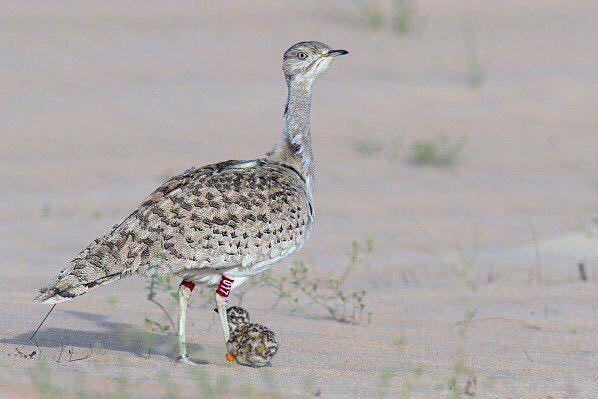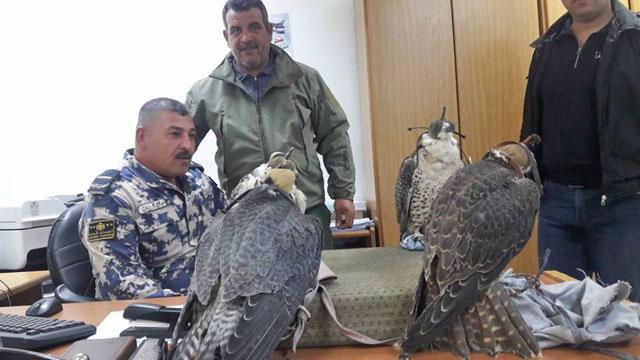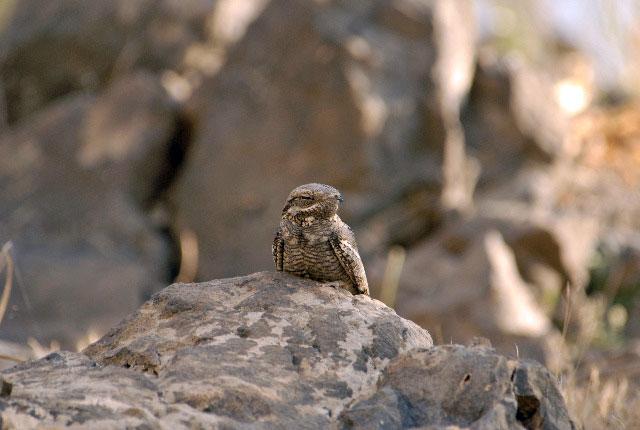You are here
Previously extinct bird reintroduced into Jordanian wildlife
By Hana Namrouqa - Jul 10,2017 - Last updated at Jul 10,2017

The houbara bustard was brought back to its historical habitat in Jordan under a programme for the reintroduction of the bird organised by the RSCN and the International Fund for Houbara Conservation (Photo courtesy of the International Fund for Houbara Conservation Facebook page)
AMMAN — Two decades after the houbara bustard became extinct in Jordan, nests and chicks of the rare desert bird are now present in the south and east of the country, according to a researcher in biological diversity.
Recognised by nature conservationists as “an icon of the Arabian desert”, the houbara bustard has been brought back to its historical habitat in Jordan under an ongoing programme to reintroduce the bird, organised by the Royal Society for the Conservation of Nature (RSCN) and the Abu Dhabi-based International Fund for Houbara Conservation.
The programme started in Jordan in 2014 as an initiative of Sheikh Mohammed Bin Zayed Al Nahyan, crown prince of Abu Dhabi and deputy supreme commander of the UAE armed forces, according to RSCN researcher in biological diversity Tareq Qaneer, who noted that the bird was last recorded in Jordan in the 1990s.
“The houbara bird, which was found in Wadi Araba and the eastern desert, became extinct in the 1990s due to the destruction of its habitat and hunting,” Qaneer told The Jordan Times.
A total of 1,300 birds have been released in their natural habitat in Jordan between 2014 and 2017, he said, noting that the International Fund for Houbara Conservation has been transferring the birds to Jordan from breeding centres abroad.
“The RSCN teams and local communities have reported sightings of houbara nests in the east of the country, nest and chicks in Wadi Araba and nesting in the Wadi Rum area,” Qaneer said.
The researcher underscored that discovering nests and chicks of the houbara indicates that the reintroduction programme has succeeded.
“The reintroduction efforts of the houbara bird are a success, with the rate reaching as high as 30 per cent, when the average success rate of a reintroduction programme is 10 per cent,” Qaneer pointed out.
The programme will carry on and more birds are scheduled to be released in Jordan under the initiative, he said.
As part of the programme, and to ensure the success of the reintroduction process, the RSCN has also worked with local communities near areas where the birds were released.
“It is vital to raise the awareness among the local communities about the bird and its critical status,” Qaneer said.
The RSCN has furthermore intensified inspection of hunting activities in places where the bird was released, Qaneer noted, underscoring that ongoing field studies are carried out to evaluate whether the birds are adapting properly.
The International Fund for Houbara Conservation has recently posted on its Facebook page results of the reintroduction programme of the houbara in Jordan. It said that observations of nests and chicks were made among a small number of houbara birds which were equipped with satellite and radio tracking devices.
“… [the observations] constitute a good indicator of the successful adaptation of these birds and their potential for reintroduction in areas from which they have disappeared in the past,” the fund said on its Facebook page.
The International Union for the Conservation of Nature (IUCN) listed the houbara on its Red List of Threatened Species as “vulnerable”.
In its explanation for categorising the bird as vulnerable, the IUCN said that the species is subject to considerable overexploitation and declines in its total population have been estimated in large proportions.
However, rates of population decline may be very rapid, and, if hunting pressure does not diminish, the species could soon warrant up-listing to a higher threat category, according to the IUCN, which also indicated that if on-going reintroduction and reinforcement strategies succeed in stabilising the population, future down-listing to a lower threat category may be considered.
The species inhabits open, arid and sparsely vegetated steppe and semi-desert and favours scattered shrubby vegetation, according to the IUCN.
Related Articles
AMMAN – A new batch of the houbara bustard, a rare desert bird that has been extinct in Jordan until recently, will be released back to its
AMMAN — Jordan is poised to host its first falconry training centre at the newly-designated Burqu Nature Reserve in the Kingdom’s eastern de
AMMAN — A Nubian Nightjar bird was spotted late last month nesting for the first time in Fifa Nature Reserve (FNR), the Royal Society for th
















